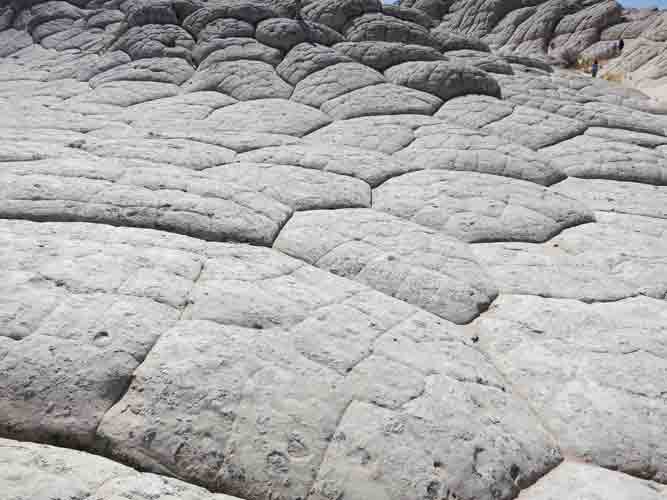
Thick massive beds at White Pocket have characteristic polygonal cracks produced by tensile stress and exposed by weathering processes. Many theories exist regarding the origin of polygonal cracks , including thermal contraction, moisture cycles, and the drying process of these sediments.
- BLM interpretive sign at White Pockets trailhead/parking area.
Don't you love a mystery?
It's true, and as the BLM Geologist at the Kanab Field Office rather accurately pointed out, "..if there was oil in it, we'd know all about how it formed" (in truth, we were discussing moqui ball formation and not polygonal cracks at the time, but that's a topic for another Listing).
So let's look at the current theories and at the end of it all, you decide which one best fits your observations. But first....
|
Logging Requirements
Email the following information/answers to me:
-
In the subject line, please include the following: "Polygons of White Pocket GC3FG6C ".
-
The number of individuals in your group.
-
Looking at the larger polygon formations, do they all have the same number of sides?
-
Follow up on the question above, if not, what do you think accounts for this variation?
-
Looking at the smaller cracks within the larger features, do they appear to be uniform in length and size?
-
Describe the texture of the rock that makes up the polygons, and compare it to some of the other features you encounter nearby.
-
What do you think accounts for the bleached surface of the polygons vs. the intense red colors of the rocks nearby?
|
Scientific theory is a contrived foothold in the chaos of living phenomena.
~ Wilhelm Reich, Austrian Psychologist.
Thermal Conduction
The thermal conduction model states that as the ground cools, that the surface contracts and there is a preferential tendency of the surface to crack into oblique angles as the surface tension of the material exceeds the tensile strength of it's ability to hold together. Various studies on permafrost areas seem to support this theory on relatively soft surfaces.
Moisture Cycles
This is probably a more common example that most people are familiar with. It involves cracks forming as moisture evaporates from a surface. What are commonly called "mudcracks" is a relatively frequent example, particularly if you live in a drier climate where monsoonal weather patterns saturate the ground, followed by intense heat.
Convection Cells
I would be remiss in not mentioning our families favorite theory. We were struck by how similar the polygonal formations match those shapes we see in the atmosphere: large scale convection cells. Convection is the "ensemble" movement of molecules within fluids, in order to transfer heat from one place to another. As a rule, convection does not occur in solids, although if this convection were taking place when the sandstone was still unformed and cemented together, and then later lithostatic forces took place afterwards, there might be room to accept such a theory.
What's your theory?
Feel free to engage in your own theory when you log a Find on this Listing. I'd love to hear what others have to say.
References and further reading:
"Scenes of the Plateau Lands and How They Came to Be", William Lee Stokes; 1969, 20th printing. Starstone Publishing Company, 333 J Street, Salt Lake City, UT 84103.
GEOMORPHOLOGYAND STRUCTURE OF THE EAST KAIBAB MONOCLINE,ARIZONA AND UTAH, by Donald L. Babenroth and Arthur N. Strahler. Bulletin of the Geologic Society of America.
Permafrost Tunnel Research Facility, Army Corp of Engineers